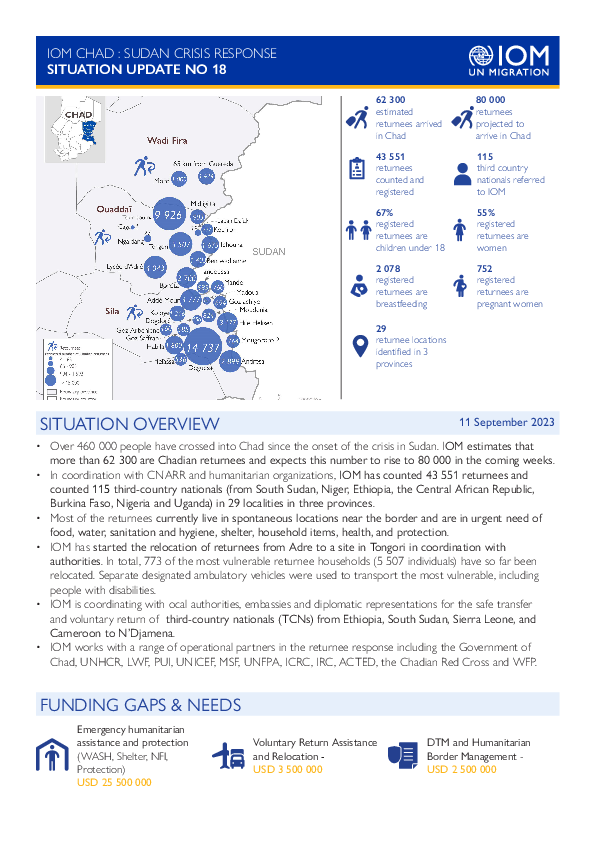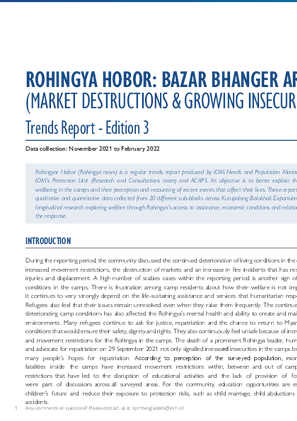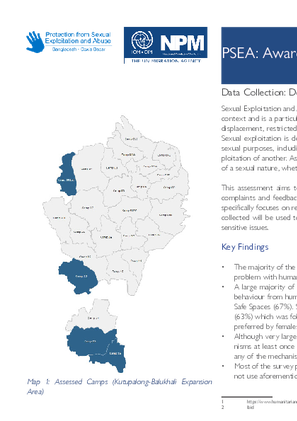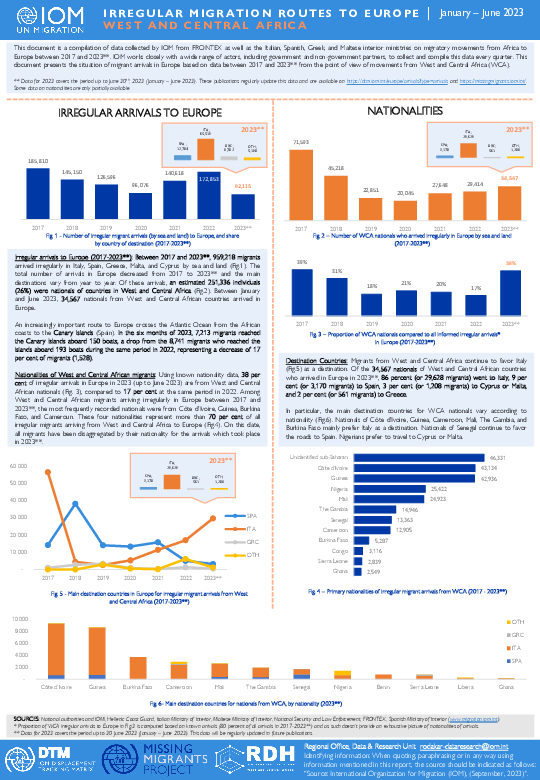-
Countries
-
Data and Analysis
-
Special Focus
-
Crisis Responses

Contact
DTM Chad, dtmtchad@iom.int
Language
French
Location
Chad
Snapshot Date
Sep 11 2023
Activity
- Survey
- Flow Monitoring Survey
- Flow Monitoring
Depuis le début des affrontements au Soudan, plus de 400 000 personnes ont traversé la frontière vers le Tchad. L’OIM estime que plus de 62 300 parmi eux sont des retournés tchadiens et s’attend à ce que ce nombre passe à 80 000 dans les semaines à venir. • En coordination avec la CNARR et les organisations humanitaires, l’OIM a déjà enregistré 43 551 retournés et 115 ressortissants de pays (Soudan du Sud, Niger, Ethiopie, République Centrafricaine, Burkina Faso, Ouganda et Nigéria) dans 27 localités dans trois provinces. • La plupart des retournés sont installés spontanément près de la frontière avec le Soudan et ont un besoin urgent de nourriture, d’eau, d’assainissement et d’hygiène, d’abris, d’articles non alimentaires, de soutien sanitaire et de protection. • L’OIM a commencé la relocalisation des retournés d’Adre vers un site à Tongori en coordination avec les autorités. 773 des ménages de retournés les plus vulnérables ont déjà été relocalisés. Des ambulances ont été utilisées pour transporter les personnes les plus vulnérables, y compris les personnes handicapées. • La réponse à la situation des retournés est effectuée en partenariat avec le gouvernement du Tchad, le HCR, la LWF, PUI, l’UNICEF, MSF, le FNUAP, le PAM, IRC, ACTED, la Croix Rouge du Tchad, et le CICR.

Contact
DTM Chad, dtmtchad@iom.int
Language
English
Location
Chad
Snapshot Date
Sep 11 2023
Activity
- Survey
- Flow Monitoring Survey
- Flow Monitoring
Over 460 000 people have crossed into Chad since the onset of the crisis in Sudan. IOM estimates that more than 62 300 are Chadian returnees and expects this number to rise to 80 000 in the coming weeks. • In coordination with CNARR and humanitarian organizations, IOM has counted 43 551 returnees and counted 115 third-country nationals (from South Sudan, Niger, Ethiopia, the Central African Republic, Burkina Faso, Nigeria and Uganda) in 29 localities in three provinces. • Most of the returnees currently live in spontaneous locations near the border and are in urgent need of food, water, sanitation and hygiene, shelter, household items, health, and protection. • IOM has started the relocation of returnees from Adre to a site in Tongori in coordination with authorities. In total, 773 of the most vulnerable returnee households (5 507 individuals) have so far been relocated. Separate designated ambulatory vehicles were used to transport the most vulnerable, including people with disabilities. • IOM is coordinating with ocal authorities, embassies and diplomatic representations for the safe transfer and voluntary return of third-country nationals (TCNs) from Ethiopia, South Sudan, Sierra Leone, and Cameroon to N’Djamena. • IOM works with a range of operational partners in the returnee response including the Government of Chad, UNHCR, LWF, PUI, UNICEF, MSF, UNFPA, ICRC, IRC, ACTED, the Chadian Red Cross and WFP.
This document is a compilation of data collected by IOM from FRONTEX as well as the Italian, Spanish, Greek, and Maltese interior ministries on migratory movements from Africa to Europe between 2017 and 2023**. IOM works closely with a wide range of actors, including government and non-government partners, to collect and compile this data every quarter. This document presents the situation of migrant arrivals in Europe based on data between 2017 and 2023** from the point of view of movements from West and Central Africa (WCA).
** Data for 2023 covers the period up to June 30th, 2023 (January – June 2023). These publications regularly update this data and are available on https://dtm.iom.int/europe/arrivals?type=arrivals and https://missingmigrants.iom.int/. Some data on nationalities are only partially available.

Contact
NPM Bangladesh, npmbangladesh@iom.int
Language
English
Location
Bangladesh
Period Covered
Mar 01 2022
Feb 28 2023
Activity
- Survey
- Community Perception
The total number of Rohingya refugees in Cox’s Bazar and and Bhasan char is around 961,729 individuals . A high majority of the Rohingya refugee population is concentrated in 33 extremely congested camps within Ukhiya and Teknaf Upazilas of Cox’s Bazar district, Bangladesh. The refugees are dependent on the assistance provided by the humanitarian community and the government of Bangladesh. In the camps, shelters are exposed to cyclic monsoons and face risk of floods, landslides, fire and cyclones. Temporary materials such as bamboo and tarpaulin have a limited capacity to resist weather impacts, and thus require regular repairs and replacement. Use of adequate material (treated bamboo, good quality tarpaulin) along with the design, site plan, proper technical details for the materials connections, can improve lifespan of materials if properly followed. Training for the beneficiaries on how to repair and maintain their shelters is also one of the essential elements of shelter assistance to ensure less dependency on humanitarian support. The SCCCM sector and its partners established Shelter Performance Standards in 2019 to set up a standard for shelter quality and have consistent guidelines to be followed over time. In order to determine if the surveyed shelters fulfill the minimum or desired standards as well as HHs perceptions on other housing-related issues, since 2021 NPM (Needs and Population Monitoring) has been conducting Shelter Performance Standard Assessment and producing the report in collaboration with the SCCCM sector. The below document represents findings from the assessment conducted by NPM on the Shelter Performance Standards 2023 which reflect shelters conditions across 33 camps. NPM in coordination with the SCCCM sector conducted similar studies in 2022 and 2021.

Contact
NPM Bangladesh, npmbangladesh@iom.int
Language
English
Location
Bangladesh
Period Covered
Sep 01 2020
Oct 31 2021
Activity
- Survey
- Community Perception
In Cox’s Bazar, identifying and meeting the unique needs of people living with disabilities has been a challenge throughout the humanitarian response, while quantitative assessments and perception tracking have struggled to understand their diverse experiences and perspectives. In November 2021, Ground Truth Solutions (GTS) and IOM Needs and Population Monitoring (NPM) embarked on a series of qualitative interviews with persons with disabilities across Rohingya refugee and host community populations with the aim of better informing and supporting agencies in developing disability-inclusive programmes and engagement activities.
This round of research focused on access to health services, with a particular emphasis on how the perceptions and experiences of persons with disabilities have changed during the coronavirus pandemic. Through gaining insight into how people with disabilities experience engaging healthcare services – as well as perceived barriers to access, information, and resources – the humanitarian community will be better equipped to identify gaps in programming and deliver more equitable services. In line with recent findings that show 'who asks the questions' can bias responses, for the data collection IOM's NPM unit mobilised its Bangladeshi-Rohingya enumerator team, including 9 women and 8 men.
Specialised training in qualitative research skills was provided over the course of three days with technical experts from the Age and Disability Working Group (ADWG) leading targeted sessions on disability inclusive communication. Interviews were conducted with the support of ADWG partners for the identification of the interview respondents and made possible by the generous contributions of our 30 respondents, whose experiences and stories form the basis of this study. Building upon the findings of this assessment, a comprehensive analysis and report will be published in February 2022.
Contact
GANBAT GERELTOGTOKH Location
Mongolia
Activity
- Mobility Tracking
- Baseline Assessment
Period Covered
Jun 01 2022 -Sep 30 2022
This dataset covers 1,640 baghs in 21 provinces of Mongolia. 504,554 households and 1, 779,600 individuals were identified. 36.5 percent of the population (649,000 individuals) were registered as minors below the age of 18; 55.6 percent (988,700 individuals) were registered as adults aged 18–59 years, and 141,900 (7.9%) were counted as elderly aged 60 and above.
Population Groups
Survey Methodology
Unit of Analysis Or Observation
Type of Survey or Assessment
Keywords
Geographical Scope
Administrative boundaries with available data
The current dataset covers the following administrative boundaries

Contact
NPM Bangladesh, npmbangladesh@iom.int
Language
English
Location
Bangladesh
Period Covered
Oct 01 2020
Sep 30 2021
Activity
- Survey
- Community Perception
Gender programming as a social intervention, addressing the diverse needs of the affected population and evaluating its impacts, is complex and challenging, particularly in a humanitarian setting where urgent survival needs are prioritised. This study observed relatively meaningful and positive shifts in gender dynamics among both the Rohingya and the host community, despite the persistence of certain harmful norms and practices. We also discovered unexpected consequences of gender interventions and read subtle ambivalent feelings towards rapid change.

Contact
NPM Bangladesh, npmbangladesh@iom.int
Language
English
Location
Bangladesh
Period Covered
Jan 01 2021
Dec 31 2021
Activity
- Other
Introduction Following the military crackdown in August 2017 in Rakhine State, Myanmar, an estimated 700,000 Rohingya refugees fled to Cox’s Bazar district, Bangladesh. Previous influxes were recorded in October 2016, when approximately 87,000 people crossed into Bangladesh, and other waves were registered during the previous decades. The total number of Rohingya refugees in Cox’s Bazar, including those residing in the district prior to August 2017 is estimated to be 925,380 individuals .
The Rohingya refugee population is concentrated in extremely congested sites within Ukhiya and Teknaf Upazilas of Cox’s Bazar district which is well known to be vulnerable due to annual monsoon and cyclone seasons. Most of the shelters where the refugees live are made of tarpaulin sheets and bamboo in areas that are either hilly or low-lying. The combination of densely populated sites and unsustainable shelter material exposes the refugee population to serious risks associated with heavy rains and high winds, such as flooding and landslides.
The Site Management Site Development Sector (SMSD) Daily Incident Report (formerly known as the SM Category 1 Daily Incident Report) was established in May 2018 to support the Rohingya refugee response during the cyclone and monsoon season. This system was developed by the SMSD Sector in coordination with the Inter Sector Coordination Group (ISCG), IOM and UNHCR. Through this assessments, Site Management Support (SMS) Agencies systematically collect information across all camps in Cox’s Bazar affected by small-scale weather related incidents. The incidents captured through this mechanism refer to small-scale localized events (such as landslides, flood, windstorm) that cause minor to moderate damage and have little to no impact outside of the locally affected area. In case of Level 2 or 3 events2 , of larger scope, the ISCG would trigger a JNA and the SMSD Daily Incident Reporting exercise would be suspended. The purpose of the system is to track any daily incidents across all camps, and their impact on the affected population.

Contact
NPM Bangladesh, npmbangladesh@iom.int
Language
English
Location
Bangladesh
Period Covered
Nov 01 2021
Feb 28 2022
Activity
- Survey
- Community Perception
During the reporting period, the community discussed the continued deterioration of living conditions in the camps, including increased movement restrictions, the destruction of markets and an increase in fire incidents that has resulted in serious injuries and displacement. A high number of scabies cases within the reporting period is another sign of cramped living conditions in the camps. There is frustration among camp residents about how their welfare is not improving. Instead, it continues to very strongly depend on the life-sustaining assistance and services that humanitarian responders provide. Refugees also feel that their issues remain unresolved even when they raise them frequently. The continued perception of deteriorating camp conditions has also affected the Rohingya’s mental health and ability to create and maintain safe social environments. Many refugees continue to ask for justice, repatriation and the chance to return to Myanmar with living conditions that would ensure their safety, dignity and rights. They also continuously feel unsafe because of increasing insecurity and movement restrictions for the Rohingya in the camps. The death of a prominent Rohingya leader, human rights activist and advocate for repatriation on 29 September 2021 not only signalled increased insecurities in the camps but also shattered many people’s hopes for repatriation. According to perception of the surveyed population, more attacks with fatalities inside the camps have increased movement restrictions within, between and out of camps. Government restrictions that have led to the disruption of educational activities and the lack of provision of formal education were part of discussions across all surveyed areas. For the community, education opportunities are essential for their children’s future and reduce their exposure to protection risks, such as child marriage, child abductions and road traffic accidents.

Contact
NPM Bangladesh, npmbangladesh@iom.int
Language
English
Location
Bangladesh
Period Covered
Jan 01 2021
Dec 31 2021
Activity
- Survey
- Community Perception
Sexual Exploitation and Abuse by humanitarian workers (“SEA”) can occur in any humanitarian or development context and is a particular risk in emergency contexts characterized by violence, gross power imbalance, mass displacement, restricted access, dismantled family and societal structures and gender and social inequalities. Sexual exploitation is defined as actual or attempted abuse of a position of vulnerability, power, or trust, for sexual purposes, including, but not limited to, profiting monetarily, socially or politically from the sexual exploitation of another. As another form of GBV, sexual abuse is defined as actual or threatened physical intrusion of a sexual nature, whether by force or under unequal or coercive conditions.
This assessment aims to understand Rohingya population’s knowledge and the perception of the available complaints and feedback mechanisms (CFMs) in the camps. Besides the general complaints, this assessment specifically focuses on reporting sensitive issues, especially on Sexual Exploitation and Abuse (SEA). Information collected will be used to improve existing complaint and feedback mechanisms and increase the reporting of sensitive issues.
Key Findings
• The majority of the respondents (80%) know what to do if they want to raise a complaint and/or face any problem with humanitarian assistance or services.
• A large majority of females (82%) would go to their families when they face a sensitive issue such as bad behaviour from humanitarian workers, which was followed by reporting the issue to the Women and Girls Safe Spaces (67%). Similarly, for males, family was mentioned by the highest number of male respondents (63%) which was followed by InfoHubs/ Information and Feedback Centers (47% of males) which were less preferred by females.
• Although very large majority of the respondents (88%) reported that they have used one of the mechanisms at least once for their complaints and feedback. the majority of the respondents (82%) did not use any of the mechanisms before for the reporting of sensitive issues.
• Most of the survey participants (55%) reported that non-confidentiality is the main reason why they would not use aforementioned channels for the reporting of any sensitive issues
